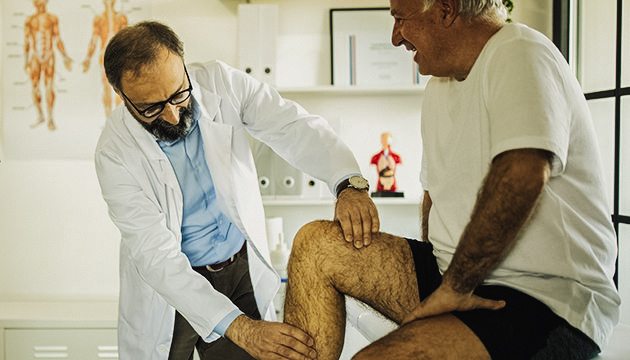Over 65 and achy? See how joint surgery could make you feel like new

Surgeon outlines improvements that help people get back quicker to what they enjoy.
Modern joint replacement has been done since the 1950s. And it’s only gotten better.
Matt Oswin, DO, an orthopedic surgeon at PeaceHealth in Bellingham, Washington, outlines a handful of improvements designed to help people return to living without joint pain.
“It’s kind of hard to believe that this procedure has been around that long,” he says. “We’ve reached a point today where it really is something that gets your life back. It lets you do what you want to do mostly pain-free.”
Reasons for replacement
Commonly, people are in their early 50s and 60s when their joints start wearing out. Over time, joints will stop working as well as they once did. That's usually when an orthopedic surgeon gets involved.
If nonsurgical options, like physical therapy, aren’t working any more, doctors might recommend replacing a natural joint that has been severely injured or if the joint has a condition like arthritis.
The goal of joint replacement is to help your joints move as well or better than they used to.
Joint replacement can also help you live longer and better, says Dr. Oswin. That’s because joint pain can have a domino effect on other aspects of your health.
If you can move without pain, you’re better able to keep your weight down. Keeping your weight at a healthy level can help you manage conditions like diabetes or high blood pressure. And when those conditions are managed, your risk for heart disease and stroke also go down.
How replacement works
Knees are by far the most common joint that get replaced, followed by hips and shoulders.
To do joint surgery, the surgeon cuts through the skin and works through the muscle and other tissue to reach the joint. The worn-out parts of the joint, cartilage and bone are cleaned up or smoothed out. The surgeon then puts metal and/or plastic parts into the joint or on the bone and closes up the area.
If you're considering a hip or knee replacement, Dr. Oswin recommends learning more about the materials that your surgeon will use. Chrome or stainless steel are long-lasting options for knees. Titanium is most common for hips.
Advances in joint replacement
Anterior hip replacement
This approach is the biggest advancement in hip replacement in the last 15 to 20 years.
Anterior means it is done from the front of the body. It uses a special surgical table and fluoroscopy (or real-time x-ray).
Surgeons can work into the joint going between muscle groups. That means better muscle function and better stability. It’s also less painful and the patient has quicker recovery.
In the United States, about 60% of hip replacements are done this way. And more than half of patients can have their hip surgery in the morning and go home that same day. “In the old days, people would often stay in the hospital two nights.”
It has been a huge shift and a big improvement, he says. The other techniques are still very good and effective. They’re used when an anterior approach isn’t the best type for a given patient.
Watch this video to see how the anterior approach works.
Reverse shoulder replacement
Shoulder replacement isn’t as common as knee or hip, but it’s an important development as more people need this kind of surgery. Shoulder pain is the third most common musculoskeletal concern (after low back pain and knee pain).
Quite often when a shoulder joint goes bad, the nearby rotator cuff or the sock tissues around that joint will have issues too, says Dr. Oswin.
“It's very difficult to do a shoulder replacement in the category of rotator cuff insufficiency or not having a functional rotator cuff or functional muscle structure around the shoulder,” he says.
Traditionally, shoulder replacement involves putting a round head onto the round head of the top of the arm bone. With the reverse technique, surgeons put the round replacement head on the shoulder side of the joint. The ball fits into the replacement socket attached to the top of the arm bone.
Standard shoulder surgery often works for many. But if you have rotator cuff issues, this alternative can give you better results with less pain and more function.
“Reverse shoulder has been a really amazing technique,” says Dr. Oswin.
Press-fit for total knee
With a press-fit technique, the surgeon doesn’t use cement or glue to attach the artificial part to the bone. Instead, the bone and replacement part grow together into a permanent bond.
Having this bond means you have better stability. And you’re less likely to need any additional surgeries to reattach the prostheses to the bone.
Press-fit has been available for hips for many years. It’s only been in the past few years that it became available for total knees. It’s best for patients whose bones are in good condition.
Watch this video on the press-fit implant.
Medial congruent, rotating platform total arthroplasty knee
These are new types of replacement parts or prostheses for knees.
Natural human knees aren’t square. The new prosthesis reduces wear on plastic parts. And it can keep the new joint from getting too loose.
People who get this medial-pivot knee design say it feels easier to walk up and down hills. This style is especially good for people who are younger and want to get back to higher intensity activities such as skiing.
“The design feels more like the natural knee joint and provides great stability and range of motion,” says Dr. Oswin.
Watch this video on rotating-platform knee prostheses.
If your achy joints hold you back, talk with your doctor about whether replacement surgery could help you get back to living better.






